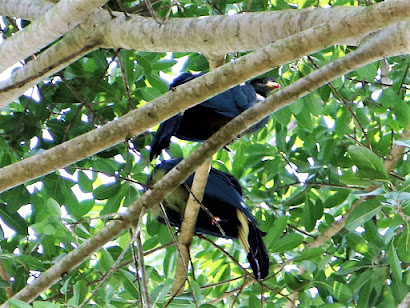Mountain Gorilla Population Rises to 459
Great news about the Mountain Gorilla conservation hit the
Ugandan and Global tourism industry at large following the press release of the
Gorilla population Census results of 2018 conducted in Bwindi ImpenetrableNational Park, one of Uganda’s UNESCO World Heritage site and the Sarambwe
Reserve in the neighboring Congo Democratic Republic indicating Gorilla
population increase.
The news was received with great excitement from all
stakeholders in the tourism and travel fraternity as it indicated an increase
in the population of the Mountain Gorillas, a species once regarded as
critically endangered now to just being endangered following the
reclassification from the IUCN (International Union for the Conservation of Nature)
last year; thanks to the Great work of conservation championed by Dian Fossey.
During the official unveiling of the results from the December
2018 Mountain Gorilla population Census, at the Kampala Serena hotel, the results
indicated an increase of 59 Mountain Gorillas from 400 in 2011 taking the Gorilla
population to a total of 459 individuals in Bwindi Impenetrable National Park.
It further showed a growth from 36 groups in 2011 to 50 in 2018 with 13
Solitary individuals. The current global Mountain Gorilla population now stands
at 1’063, meaning a total of 604 Mountain Gorillas rests in the greater Virunga
Massif, a physical landscape that spreads across Uganda, Rwanda and the
Democratic Republic of Congo.
The great achievement regarding gorilla population increase has
been attributed to the involvement of local communities in conservation
programs and various tourism activities. Conservationists and wildlife experts
noted that a portion of the revenue generated from gorilla tourism (permits and
park entrance fees among others) is directed towards empowering communities as
well as supporting local community initiatives like livestock, agriculture, and
craftsmanship like artworks purchased by tourists as souvenirs.
However, the study still revealed that this member of the world’s
Great Apes, and one of the most sought after wildlife species is still under
threat from illegal human activities like poaching within the reserves,
resulting from the findings where more than 80 traps were found and destroyed
during the census activity.
The Gorilla
population census is funded by the International Gorilla Conservation Programme
(ICGP), a global agency dedicated to protecting the Mountain Gorillas and their
habitat, with support from other partners like the WWF Uganda, the Rwanda
Development Board (RDB), the Greater Virunga Transboundary Collaboration and
other partners.
“Slowly but certainly a solid future for the Mountain Gorillas
is emerging, proving that long-term, collaborative conservation efforts can
pull species back from the brink of extinction.” Anna Behm Masozera,
director of the International Gorilla Conservation Programme (IGCP) coalition, stated.
This was the fifth Gorilla population census within Bwindi since
1997 a count that revealed 300 individuals but it is the first of a kind
including the Sarambwe Nature Reserve.
"As in the previous mountain gorilla population
census conducted in the Virunga Massif, survey teams walked pre-determined
“recces” (reconnaissance trails) ensuring a thorough coverage of all forest
areas to sweep the Bwindi-Sarambwe and search for signs of Gorillas, other key
mammals, and human activities. When fresh gorilla signs were detected, the
teams followed the gorilla trail to locate three recent night nest sites. At
each of these nest sites, the teams collected fecal samples from nests.
The process was completed twice; first from
March to May 2018 (62 days) and second from October to December 2018 (60 days).
A second sweep allows to find gorillas that were undetected during the first
sweep and thus provides more reliable numbers of gorillas. Fecal samples were
analyzed genetically to determine individual genotypes. The survey teams also
collected data on signs and sightings of select mammals, such as chimpanzee and
elephants, and human activities, such as snares or tree cutting. While
exercising caution due to the limitations of the study, there were no
indications of declines in populations for the select mammals surveyed,
including Elephants, since 2011”.
The survey was conducted by the Protected Area Authorities of Uganda and DRC (Uganda Wildlife Authority and l’Institut Congolais pour la Conservation de la Nature, respectively) under the framework of the Greater Virunga Transboundary Collaboration with support from Rwanda Development Board and many other partners and donors” according to GVTC
The great news about Gorilla population
increase came in as a Christmas package to the tourism fraternity and this
indicates a green light in the conservation, gorilla tourism and Uganda Safaris.
Gorilla tracking ranks as Africa’s premier wildlife experience and among the
world’s best. Trekking through the misty mountain forest is exquisite and
adventurous and eventually meeting with the gorillas, staring deep into the
eyes of this great Ape is such an emotional moment you will have during your African
Holidays. Mountain Gorillas are some of Africa’s best kept but no longer secret.
To have a perfect and flawless Gorilla Safari
Tour in Uganda, Avens Travel World is your Africa travel companion, we shall tailor all your needs in one itinerary to make
your African Safari a moment of greatness.



Comments
Post a Comment